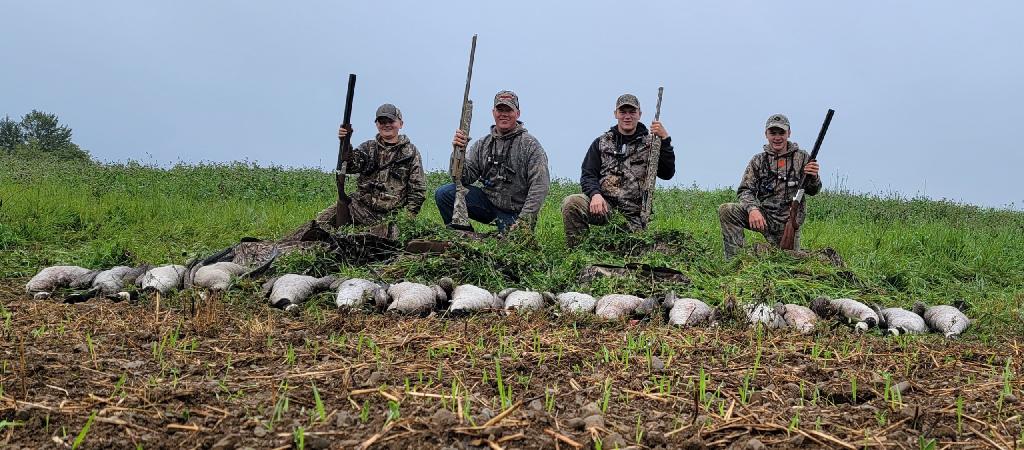
The advances in goose and duck decoy appearance, construction, technology, and tactics have skyrocketed over the last 25 years. Rag bodies, silhouettes, and shells have greatly improved paint jobs. Some companies even use photos of real geese on their models. Several manufacturers offer upwards of 20 postures for feeding, resting, alert, semi-alert, and calling birds to assure realism. A few full-body honker decoys are fully flocked; it started as just flocked heads, but now the non-glare, textured flocking application truly resembles real feathers.
Perhaps the most beneficial improvements to duck and goose decoys has been the introduction of movement to imitate a flock of real birds in motion. Due to a goose’s keen eyesight that detects the slightest movement of a hidden hunter, the cardinal rule of success has always been to wear full camo clothing head to toe and stay completely immobile until it’s time to shoot. While stillness remains crucial for gunners and dogs, adding some motion to the fake flock helps distract approaching birds a bit from hidden hunters.
Waving a flag to imitate landing waterfowl is an old tactic to get the attention of distant flocks flying past. Once birds turn for a closer look, it’s time to stow the flag and begin using calls. One-color cloth flags have been replaced by waterproof, full-size silhouettes of geese and ducks on a 3-to4-foot handle to be waved manually.
A more elaborate version of the goose flag is a goose kite. Cut and colored to imitate a flying goose, the lightweight but durable material actually floats and flies on the mildest of breezes. You can either wave the flag by hand or stake it into the ground.

Windsock decoys were the first ground-staked type of motion decoy and are still used by many hunters due to their ease of transport and deployment as well as low cost per dozen. Any breeze will inflate the sock body which is painted to imitate a species of duck or goose and cause it to sway gently from side to side like a moving, feeding bird. Put out 2 or 3 dozen and they resemble a moving mass of live waterfowl that draw passing flights to investigate, but there must be wind for it to work.
The hierarchy of decoys from least to most effective, and coincidentally lowest to highest price is as follows: rags, wind spinners, wind socks, silhouettes, shells, full bodied, and motorized full body or flappers. The more realistic the decoy, the fewer needed to build a spread that will hoodwink sharp-eyed waterfowl within shotgun range
Over the last 50 years, I’ve hunted over every imaginable type of waterfowl decoy, from car tires cut into three sections and hand painted with a cut-out plywood head on a metal stake to a flock of 50 taxidermy real goose bodies in lifelike poses. For consistent, season long shooting, top of the line, full-bodied, fully flocked dekes on motion stakes offer the best option.
While life-size, or the larger than life magnum size decoys, with realistic feather detail in soft- non-glare flocking are effective, the motion stakes are the real key to success. I prefer Green Head Gear, Pro Grade fully flocked decoys manufactured by Avery Outdoors. There are various body positions available in 6 packs of feeder, harvester, and active body positions including a 6-slot transport bag as well as a set of Real motion stakes and also a set of stands to use when the ground is frozen or too hard for stakes. Half a dozen GHG Canada goose decoys cost about $250 with all the accessories, but quality isn’t cheap and these are as close to imitating a real flock as I’ve seen.
There’s no doubt that a full body decoy looks most realistic from every angle that a live goose might approach, even directly overhead. Most other styles, especially one dimensional silhouettes, don’t provide this realistic view. Size, feather detail and coloration as well as a bit of movement are crucial decoy features to fool the keen eyes of dozens of honkers as they approach a fake flock.
Sturdy, but lightweight, easy to carry, deploy into the ground and pick up, and reasonably priced are prime requisites for a great decoy. Higdon (higdondecoys.com) much to my surprise and pleasure has created a new silhouette style, called Flats, that meets all these goals and more. They even produce very realistic movement in the lightest breeze and a dozen can easily be carried and deployed by one hunter in 3 or 4 minutes. Try that with full body models! At a fraction of the price of full bodies and shells, Higdon Flats will save set-up time, money, storage space and produce more birds in the game bag.

Last but certainly not least are the epitome of realism – battery operated, remote control motorized spinning and flapping wing decoys. A group of hunting companions arrived from downstate last fall with two of Lucky Duck Companies Lucky Flapper Canada goose decoys, and by the end of the outing I knew I had to own one myself. It really takes the place of a goose flag. Lucky Goose can be set to continuous or intermittent motion and a remote control not only turns it on and off but adjusts wing speed and works from as far as 100 yards away
Any motion or movement in and around a waterfowl decoy set up is bound to add realism to an otherwise static set up, and attract more birds to investigate. Just as important, when many of the eyes of an approaching flock are focused on moving decoys, they are not on the blinds and hunters. Native goose season begins in early September, the two-month regular season close behind, get your fake flock ready and add a bit of motion to buoy success.







